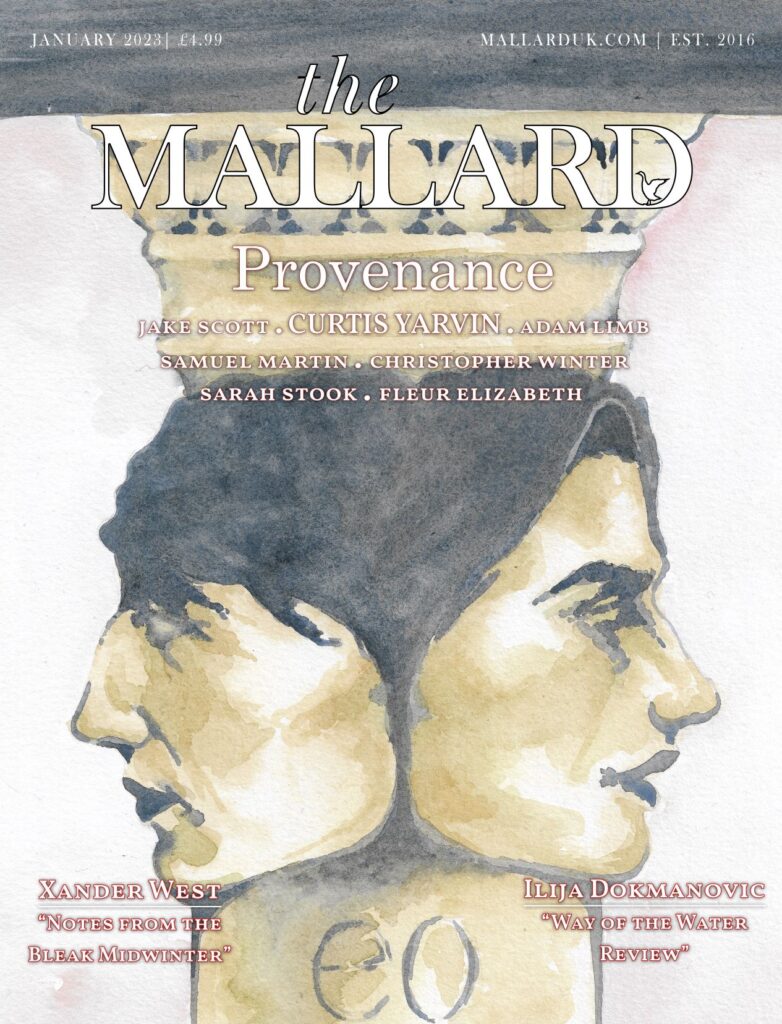Samurai Jack was an American animated TV series that premiered on Cartoon Network in 2001 and ran for, eventually, five seasons. The story follows the adventure of an unnamed samurai travelling through a dystopian future governed by a demonic wizard named Aku. What makes Samurai Jack unique is the moral paradigm that can be read into the central premise of the plot, neatly summarised by the tagline of the opening sequence: ‘Gotta get back, back to the past, Samurai Jack.’
The world that the samurai fights to destroy – a world corrupted at every level by Aku’s evil – is unambiguously modern in character. When he is cast through a time portal at the end of the first episode, he falls out into the squalid depths of a futuristic inner city ghetto. He drops out of the sky into a world of towering black skyscrapers, massive electronic billboard advertisements and sky-streets jammed with flying motorcars. The thunderous roar of the city’s traffic disorients and terrifies him.
After barely surviving his dramatic entrance, he is greeted by some locals who give him the name ‘Jack’ and speak to him in what is easily recognisable as a modern urban patois. ‘Yo, Jack! That was some awesome show!’ ‘Word! Jack was all ricochetically jump-a-delic!’ Their manner of speech contrasts heavily with Jack’s own old-fashioned and deliberately measured standard English. When Jack hesitantly asks where he is, he is told by these odd strangers that he is in the ‘central hub’ of Sector D. This is a placeless place, devoid of history or culture and labelled a ‘hub’ of a ‘sector’ in familiarly modern and soulless bureaucratic fashion.
Jack then stumbles into a seedy nightclub where he becomes even more distressed than before. He holds his hands to his ears, desperate to block out the loud, thumping techno music, and looks around wild-eyed at a room full of scantily-clad dancers and hideous aliens with bionic body parts. This new world is too bright and too loud for Jack. The world he came from is tranquil, soft and full of flower-filled meadows, rolling hills and beautiful snow-topped mountains. Aku’s world is vulgar, harsh and obnoxious. Jack is a man out of time, questing through the future in order to return to the past. He fights to turn the clock back in order to prevent the world around him from ever existing and to save the world he once knew. The tale of Samurai Jack is a reactionary, luddite Odyssey.
The first scene of the first episode is like something out of a bad psychedelic trip or a nightmarish fever dream. Everything is uncanny – the sun and moon are too large, the landscape is barren and red and the lone piece of flora in the scene is a twisted black tree. The giant moon eclipses the sun, shooting red lightning through the sky as the tree twists and morphs into the demon Aku. This terrifying moment, complete with deliberately unsettling sound effects, masterfully introduces the show’s main antagonist. It is also a prime example of Tartakovsky’s use of the environment instead of dialogue to evoke emotion and convey information about his characters.
Aku is able to see Jack through a magic mirror at all times, he can shapeshift endlessly and is immune to all physical weapons. Aku is more than a demon wizard – he is a malevolent god. He is informed instantly of Samurai Jack’s arrival in the future by his informant network that, throughout the show, seems to extend into every nook and cranny of the universe. Aku’s armies are inexhaustible, dwarfed only in size by the intergalactic mining operation he employs to sustain it. The entire universe is in the grip of an Orwellian state in the service of a quasi-Gnostic demiurge. The central premise of the show itself implies the extent of Aku’s dominance – dominance so complete as to be completely insurmountable, and able to be defeated only through time travel. Genndy Tartakovsky’s finest creation is a kids TV show set in a world that is incomprehensibly awful, where the main character faces completely hopeless odds and the main antagonist is all-powerful. Jack stands alone, armed only with a magic sword and the power of righteousness, and yet it somehow feels as though Aku fears him more than he fears Aku.
For the first four seasons Jack is an unchanging constant as the setting around him is repeatedly changed in line with his journey. Dialogue and character development are conspicuously limited in contrast to many other shows, but this speaks to the genius of Samurai Jack’s unique formula. The relationship between the main character and the setting are reversed – Jack is the unchanging stage. The story takes place around him but he stays the same, dressed in his characteristic white robes, forever a fish out of water. The only exceptions to this rule are the first episode, where Jack’s character is established, and the final season on Adult Swim, which takes a different and more mature tack.
Genndy Tartakovsky’s work for Cartoon Network is understandably constrained by limits of what is appropriate for children to watch before school, but when the show was moved to Adult Swim it became free to explore darker themes. For the first four seasons, Jack turns his deadly sword on his robotic and demonic enemies only. This allowed Tartakovsky to showcase Jack’s skill, defeating hordes of enemies that sometimes cover the entire horizon, without any graphic violence. The fact that Jacks opponents until the final season remain the minions of Aku, which are overwhelmingly robots, rather than the flesh-and-blood inhabitants of his fallen world is another way in which Aku and his evil are made to seem industrial in character, in opposition to noble, agrarian Samurai Jack.
The entire show is hand-drawn without outlines so that characters blend into their backgrounds. Lineless drawings give the animation a rudimentary, child-like appeal as well as greater flexibility with regard to proportions so that all of the characters’ movements feel powerful and dynamic. Action scenes are one of the great strengths of Tartakovsky’s cartoons – evident in Star Wars the Clone Wars (2003) earlier in his career right through to Primal, which aired just recently in 2019. All of this combined with the use of comic book-esque screen framing make the series feel more like a graphic novel come to life or an anime series than a Western kids cartoon. What’s more, Samurai Jack accomplishes this without sacrificing childish entertainment value.
However, what makes Samurai Jack stand out in a sea of well-animated cartoons is the story. Jack is a unique character that represents a sentiment not often explored in visual media – the sense of longing for a world you’re not even sure exists, or ever existed. The world around Jack is fetid and evil – but the world he remembers, was it ever truly as good as he remembers it to be? Was the world that was ever free of the corruption and evil that so disgusts him about the world – the ‘world that is Aku’ – that he fights to undo? Jack’s sense of alienation is deeper than that of a stranger in a strange land – he is a man trapped at the wrong place in time entirely. Not only is the world foreign, but everything is laced with and governed by Aku’s evil. The very ground on which he walks, the air through which he moves, is hostile to him. In our world where seemingly nothing can escape the plastic-coated grip of modernity, this cartoon asks whether it really is so crazy to feel like you’ve gotta get back, back to the past, Samurai Jack.




